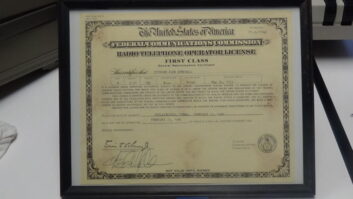
Earl Bullock, a pioneer in the field of radio station automation, died on Jan. 30 in Plano, Texas. He was 82.
Bullock is perhaps best remembered for helping to transition an automation system originally developed in the late 1950s by Paul Schafer from electromechanical to solid-state sequencing. Bullock’s work ultimately led to the Schafer 903, which became an industry standard for radio program stream automation and was used by hundreds of stations around the world.
Interestingly, Bullock’s background and early employment did not include the broadcast industry. He studied electrical engineering at Kansas State University, and participated in several General Electric industrial electronics engineer-in-training programs before receiving his bachelor of science in electrical engineering degree in 1954. After a two-year hitch with the U.S. Army Signal Corps, he returned to General Electric and a job in the advanced engineering department at the company’s General Purpose Control Division in Bloomington, Ill. There, he helped the operation move away from relays and magnetic amplifier designs to solid-state components and eventually logic gates. He continued his career in industrial control electronics, moving in the early 1960s to southern California to work in 3M’s instruments division operation.
In 1970 he was hired by Paul Schafer’s radio programming automation company in the aftermath of a plan by that company to move to a minicomputer platform for driving sequencing operations. The computer that Schafer’s company had developed was beset with problems and extremely unreliable. Bullock, only partially joking, recalled that the mean time between failures was only about two hours.
Ultimately, the minicomputer plan was scrapped, and Bullock was given the job of designing a programmable solid-state control system that could operate without reliance on software loads. This became the nucleus of the Schafer 903 system. Bullock noted that the circuit design was finalized just a few days short of the scheduled completion date for the project.
Bullock became Schafer’s vice president of engineering and remained with the company and its successor organizations — Applied Magnetics and Cetec — until 1980. He relocated to Texas that year, first working for Century 21 Programming (later TM Century) and then launching his own company, Broadcast Automation Inc., which refurbished and remanufactured automation gear that he had designed.
Bullock’s career took him to radio operations all across America and around the world. However, his knowledge of the equipment was so thorough that in most instances he could diagnose problems and offer solutions via telephone. Bullock also did work for Clear Channel/RCS/Prophet Systems, officially retiring in 2011. But, according to his daughter, Shari Wallace, he was still doing radio station work on a contract basis into last year.
Earl made many friends in the industry and was a regular at the NAB Show.
Contributions in memory of Earl Bullock may be made to the American Cancer Society.







